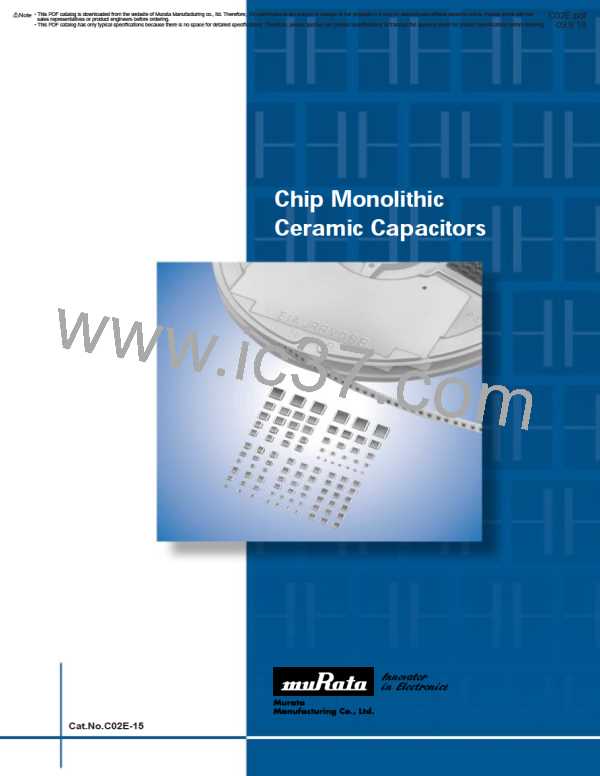• This PDF catalog is downloaded from the website of Murata Manufacturing co., ltd. Therefore, it’s specifications are subject to change or our products in it may be discontinued without advance notice. Please check with our
• Please read rating and !CAUTION (for storage, operating, rating, soldering, mounting and handling) in this catalog to prevent smoking and/or burning, etc.
!Note
!Note
C02E.pdf
sales representatives or product engineers before ordering.
• This catalog has only typical specifications because there is no space for detailed specifications. Therefore, please approve our product specifications or transact the approval sheet for product specifications before ordering0. 9.9.18
• This PDF catalog has only typical specifications because there is no space for detailed specifications. Therefore, please approve our product specifications or transact the approval sheet for product specifications before ordering.
LLL/LLA/LLM Series Specifications and Test Methods (1)
LLL/LLA/LLM Series Specifications and Test Methods (1)
In case Non "*" is added in PNs table, please refer to LLL/LLA/LLM Series Specifications and Test Methods (1).
In case "*" is added in PNs table, please refer to LLL/LLA/LLM Series Specifications and Test Methods (2).
Specifications
No.
1
Item
Operating
Temperature
Range
Test Method
R7, C7: Y55 to W125°C
3
The rated voltage is defined as the maximum voltage which
may be applied continuously to the capacitor.
When AC voltage is superimposed on DC voltage, V or V ,
P-P
O-P
2
Rated Voltage
See the previous pages.
whichever is larger, should be maintained within the rated
voltage range.
Visual inspection
Using calipers
3
4
Appearance
Dimensions
No defects or abnormalities
Within the specified dimension
No failure should be observed when 250% of the rated voltage
is applied between the terminations for 1 to 5 seconds,
provided the charge/discharge current is less than 50mA.
5
Dielectric Strength No defects or abnormalities
CV0.047µF: More than 10,000MΩ
Insulation
The insulation resistance should be measured with a DC voltage
not exceeding the rated voltage at 25°C and 75%RH max. and
within 2 minutes of charging.
6
7
CG0.047µF: More than 500Ω · F
Resistance
C: Normal Capacitance
Capacitance
Within the specified tolerance
The capacitance/D.F. should be measured at 25°C at the
frequency and voltage shown in the table.
Frequency: 1T0.1kHz
Voltage: 1T0.2Vrms
*For LLA185C70G474, the capacitance should be measured
unsing a voltage of 0.5±0.1Vrms.
W.V.: 25V min.; 0.025 max.
W.V.: 16V/10V max.; 0.035 max.
W.V.: 6.3V max.; 0.05 max.
Dissipation Factor
(D.F.)
8
The capacitance change should be measured after 5 min. at
each specified temperature stage.
Step
Temperature (°C)
25T2
1
2
3
4
5
Y55T3
25T2
125T3
25T2
Temp. Range
(°C)
Y55 to +125
Y55 to +125
Reference
Capacitance
Temperature
Characteristics
Char.
Cap.Change
Temp.
25°C
25°C
9
Within T15%
Within T22%
R7
C7
The ranges of capacitance change compared with the 25°C
value over the temperature ranges shown in the table should
be within the specified ranges.
• Initial measurement.
Perform a heat treatment at 150+0/-10°C for one hour and then
set for 24±2 hours at room temperature. Perform the initial
measurement.
Solder the capacitor to the test jig (glass epoxy board) using a
eutectic solder. Then apply 10N* force in parallel with the test
jig for 10T1 sec. The soldering should be done either with an
iron or using the reflow method and should be conducted with
care so that the soldering is uniform and free of defects such as
Adhesive Strength
of Termination
10
No removal of the terminations or other defect should occur.
heat shock.
*LLL18 and LLA/LLM Series: 5N
Appearance
Capacitance
No defects or abnormalities
Within the specified tolerance
Solder the capacitor to the test jig (glass epoxy board) in
the same manner and under the same conditions as (10). The
capacitor should be subjected to a simple harmonic motion
having a total amplitude of 1.5mm, the frequency being varied
uniformly between the approximate limits of 10 and 55Hz. The
frequency range, from 10 to 55Hz and return to 10Hz, should
be traversed in approximately 1 minute. This motion should be
applied for a period of 2 hours in each of 3 mutually
Vibration
Resistance
D.F.
11
W.V.: 25V min.; 0.025 max.
W.V.: 16V/10V max.; 0.035 max.
W.V.: 6.3V max.; 0.05 max.
perpendicular directions (total of 6 hours).
Immerse the capacitor in a solution of ethanol (JIS-K-8101) and
rosin (JIS-K-5902) (25% rosin in weight proportion). Preheat at
80 to 120°C for 10 to 30 seconds. After preheating, immerse in
eutectic solder solution for 2T0.5 seconds at 230T5°C, or
Sn-3.0Ag-0.5Cu solder solution for 2T0.5 seconds at 245T5°C.
Solderability of
Termination
75% of the terminations are to be soldered evenly
and continuously.
12
Appearance
No marking defects
Preheat the capacitor at 120 to 150°C for 1 minute. Immerse
the capacitor in a eutectic solder or Sn-3.0Ag-0.5Cu solder
solution at 270T5°C for 10T0.5 seconds. Let sit at room
temperature for 24T2 hours, then measure.
Capacitance
Change
Within T7.5%
Resistance
W.V.: 25V min.; 0.025 max.
W.V.: 16V/10V max.; 0.035 max.
W.V.: 6.3V max.; 0.05 max.
13 to Soldering D.F.
Heat
• Initial measurement.
+0
Perform a heat treatment at 150
°C for one hour and then
–10
I.R.
More than 10,000MΩ or 500Ω · F (Whichever is smaller)
let sit for 24T2 hours at room temperature. Perform the initial
Dielectric
Strength
measurement.
No failure
Continued on the following page.
81

 MURATA [ muRata ]
MURATA [ muRata ]